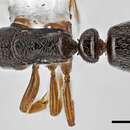en
names in breadcrumbs


Habitat: Usually abundant wherever there is moist, at least moderately rich soil, whether shaded or open, moist to dry-mesic, and even in highly degraded habitats such as lawns, gardens, fencerows, successional fields and thickets. P. pennsylvanica also occurs in sedge hummocks in fens. In prairie, it nests in the root-zone of sedges or grasses. In woodland, it nests in soil, in soft, rotten wood, and often in old acorns or occasionally other nuts.
Diet:
Natural History: P. pennsylvanica is a generalist predator of small, soft-bodied invertebrates. I once found about 30 workers feeding on a smashed beetle larva under a rock. Colonies are small, rarely containing over 100 workers. Alates may be encountered, usually flying near trees, on clear late summer days.
Taxonomic history
Emery, 1895d PDF: 267 (q.m.); Wheeler & Wheeler, 1952c PDF: 631 (l.).Subspecies of Ponera coarctata: Emery, 1895d PDF: 267; Dennis, 1938 PDF: 277; Creighton, 1950a PDF: 48.Revived status as species: Taylor, 1967a PDF: 29.
Ponera pennsylvanica is a species of ant that is usually found in mesic forests in the Eastern United States. The species' nests are usually found under rotting logs, in rotting stumps or logs, in acorns, in soil, and in leaf mold.[1] Ant colonies usually have no more than 100 worker ants.[2]
Ponera pennsylvanica is a species of ant that is usually found in mesic forests in the Eastern United States. The species' nests are usually found under rotting logs, in rotting stumps or logs, in acorns, in soil, and in leaf mold. Ant colonies usually have no more than 100 worker ants.